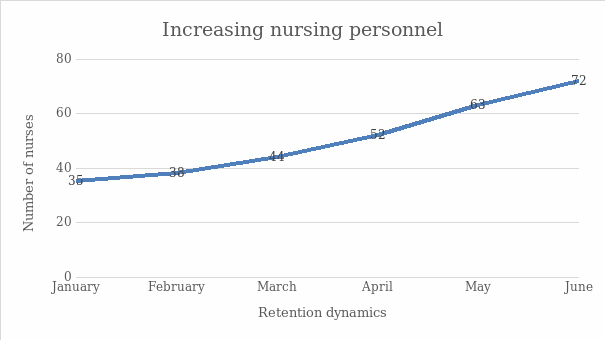Introduction
Increasing the number of full-time nurses at United Medical Rehab is a critical task to achieve in order to address staff shortages and declining patient outcomes. According to Drennan and Ross (2019), the shortage of junior medical employees is a global problem, largely caused by inadequate recruitment and retention policies.
Discussion
As a quality improvement initiative, an increase in the number of full-time nurses in the healthcare facility in question is considered. Based on current performance, the proposed six-month intervention will be based on creating conditions for nurse retention and reorganizing recruitment programs. Increasing wages and additional stimuli, for instance, involvement in planning activities, are important factors in achieving the goals set. In addition, the purpose of improving patient outcomes is planned to be achieved through increased staffing and, therefore, more efficient care. In Figure 1, the schedule and outcomes of the quality improvement initiative are presented, and the numerals are related to the number of employees in the healthcare unit.

By following the data in Figure 1, one can notice a direct correlation between changes in retention and recruiting policies with an increase in the number of nurses. After the end of the six-month improvement program, the number of junior medical employees is planned to be at least doubled, thereby addressing the issue of staff shortage. Regarding the dynamics of changes, it is planned to be relatively stable since the traditional methods of attracting and retaining will be applied. As Marufu et al. (2021) state, financial incentives, such as regular bonuses, are powerful approaches to motivating performance and retention. In the context of the healthcare under consideration, the deterioration in patient outcomes is a direct consequence of omissions on the part of the HR department. Increasing the number of employees and motivating them through adequate tools are the conditions for ensuring sustainable care and quality of medical assistance to the population.
Conclusion
In a real-world setting, applying effective retention tools means paying monthly financial bonuses to nurses who are the most productive. In addition, since the material aspect is one of the key motivators, an increase in wages for junior staff is a planned intervention. The implementation of these tasks requires an increase in expenses from the budget of the medical facility, but in the long run, such decisions will justify themselves.
References
Drennan, V. M., & Ross, F. (2019). Global nurse shortages: The facts, the impact and action for change. British Medical Bulletin, 130(1), 25-37. Web.
Dyas, A. R., Bronsert, M. R., Meguid, R. A., Colborn, K. L., Lambert-Kerzner, A., Hammermeister, K. E., Rozeboom, P. D., Velopulos, C. G., & Henderson, W. G. (2022). Using the surgical risk preoperative assessment system to define the “high risk” surgical patient. Journal of Surgical Research, 270, 394-404. Web.
Handley, N. R., Schuchter, L. M., & Bekelman, J. E. (2018). Best practices for reducing unplanned acute care for patients with cancer. Journal of Oncology Practice, 14(5), 306-313. Web.
Marufu, T. C., Collins, A., Vargas, L., Gillespie, L., & Almghairbi, D. (2021). Factors influencing retention among hospital nurses: Systematic review. British Journal of Nursing, 30(5), 302-308. Web.
